Sphinginae subfamily
Sphingini tribe:
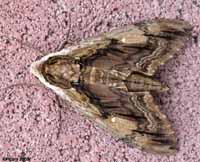 |
The upperside of the forewing is brown with dark brown and white
markings including a white costal area near the wing base, dark
streaks along the veins, and a white spot in the cell.
The upperside of the hindwing is light brown and has a dark brown
band along the outer margin.
|
Ceratomia amyntor larva, Doug Freestone
 |
The upperside of the forewing is pale brownish gray with wavy black and white
lines and a black-outlined white cell spot.
|
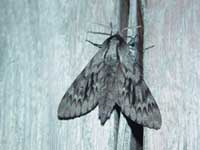 |
The upperside of the forewing is gray with heavy black bands.
The upperside of the hindwing is brownish gray with no markings.
If you have pines, you
probably have this species. It also flies on P.E.I.
|
 |
Manduca quinquemaculatus
WO?,
the Five-spotted Hawkmoth
The moth abdomen usually has five but sometimes six pairs of yellow
bands. The upperside of the forewing is blurry brown and gray.
I suspect if you grow tomatoes, you are likely to encounter it.
|
 |
Sphinx chersis
WO?, the Northern Ash Sphinx or Great Ash Sphinx
The upperside of the forewing is soft dark gray to blue-gray
with a series of black dashes, one of which reaches the wing tip.
|
 |
Forewings, long and slender, are held close to the body when the
moth is at rest. This moth is similar to Sphinx vashti.
|
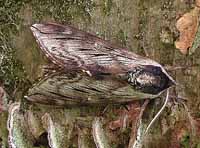 |
Sphinx gordius
WO?, probably poecila, the
Apple Sphinx
The upperside of the forewing ranges from brown with black borders
through brownish gray with paler borders to pale gray with no
borders. |
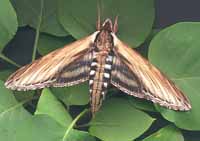 |
The lower forewings are predominantly brownish-yellow with a fairly
wide dark bar along the inner margin. At rest the wings hug the body,
giving the moth a long slender look.
|
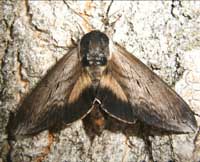 |
Sphinx luscitiosa
WO?,,
Canadian Sphinx or
Clemen's Sphinx.
FW upperside is yellowish gray in males and pale
gray with faint yellow tint in females. In both sexes, dark
border on the outer margin widens as it approaches inner margin.
HW upperside is deep yellow in males, pale yellow in
females; both with wide black border.
|
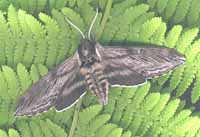 |
If you have blueberries in the woods, then you probably have the
Poecila Sphinx. They are probably widespread throughout Wisconsin,
but are very much under reported. |
 |
Sphinx vashti
WO?, the Snowberry Sphinx,
Snowberry Sphinx adults fly as a single brood in montane woodlands and along prairie
streamcourses from April to August.
The upperside of the forewing has a narrow black subterminal line
bordered by a white inverted V-shaped line on the outside, and a
black line at the apex. |
Smerinthini Tribe:
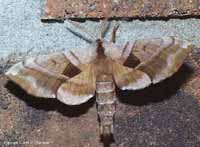 |
Amorpha juglandis
WO?? questionable,
the Walnut Sphinx
The adults are also highly variable; sometimes wings of an individual
may be all one color or may have several colors, ranging from pale to
dark brown, and may have a white or pink tinge.
See the file for the female; she is different.
|
 |
The outer margin of the forewing is quite wavy. There is a dark cell
spot and a dark oblique line mid wing from the costa almost to the
inner margin. Basic ground colour is pinkish brown. Flight would
be June-July. |
 |
Paonias myops
WO?,
the Small-eyed Sphinx
This species
ranges
across North America.
The hindwings have a small blue eyespot ringed with black on a
yellow background.
|
 |
Pachysphinx modesta
WO?,
the Modest Sphinx or Poplar Sphinx,
Hindwings are reddish purple with dark blue near anal angle.
They are a heavy bodied species.
|
 |
Smerinthus cerisyi
WO?, the Cerisyi's
Sphinx or One-eyed Sphinx, Larvae feed on poplars and willows.
Flight would be from late May-July as a single brood.
|
 |
Smerinthus jamaicensis closely resembles Smerinthus cerisyi, but
jamaicensis is much smaller with larger blue patches on more
vibrant and deeper purple in the lower wings.
|
Macroglossinae subfamily
Dilophonotini Tribe:
See Hemaris comparison to help distinguish
the next three species.
 |
Hemaris diffinis
WO?, the Snowberry Clearwing or Bumblebee Moth,
The moth flies along forest edges and in meadows, gardens and
brushy fields. Day-flying adults nectar at lantana, dwarf bush honeysuckle,
snowberry, orange hawkweed, thistles, lilac, Canada violet, etc. |
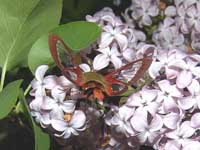 |
Hemaris gracilis
WO?, The Slender Clearwing or Graceful
Clearwing
This day flier is not commonly reported.
|
 |
Hemaris thysbe
WO?, the Hummingbird Clearwing
It is not difficult to see why many gardeners would mistake an
Hemaris thysbe moth for a small hummingbird as it hovers, sipping nectar
from flowers through a long feeding tube. |
Philampelini tribe:
 |
This moth is reported for Ontario, and it is fairly often reported
along the east coast from southern New Jersey
to central Maine.
Note the differences between this moth and the Pandorus Sphinx.
|
Eumorpha achemon larva, Karen Edwards
Macroglossini Tribe:
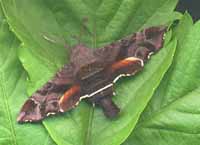 |
This day flier is widely distributed. If you have Virginia Creeper,
you might have the Nessus Sphinx. Two bright, distinct, narrow
yellow bands are often visible on the abdomen.
|
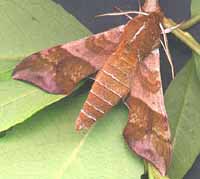 |
They are common in New Jersey and common
here on Prince Edward Island.
You will often see this species listed as Darapsa pholus,
especially in older literature.
|
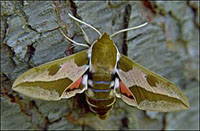 | The body is light brown with various white and dark brown
markings, while the wings have a conspicuous tan, brown, and pink or
red color pattern.
|
Hyles euphorbiae larva, Zehner (12 miles NE of Regina), Dave Fries
Hyles euphorbiae larva, Swift Current, Marnie Kay-Macmillan
 |
Hyles gallii
WO?, the Bedstraw Hawk Moth
or Gallium Sphinx
This species is not reported in Sheboygan, but it has been recorded
in other eastern Wisconsin counties. I suspect it is present.
Some years I see them on P.E.I., some years, I do not.
|
 |
Hyles lineata
WO?, the White-lined Sphinx
Adults usually fly at dusk, during the night, and at dawn, but they
also fly during the day over a wide variety of open habitats
including deserts, suburbs, and gardens. |
 | Proserpinus flavofasciata adults fly from
April-June in meadows in coniferous forests. Adults fly during the
afternoon, nectaring from lilac, dandelion, cherry, etc.
|
 |
The upperside of the forewing is pale gray-green with a deep
green-brown median area and a white dash at the wing tip.
|
|
|





























